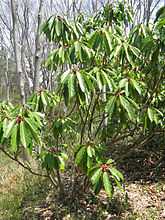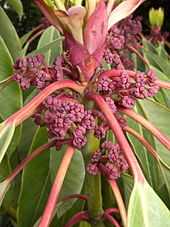Daphniphyllum macropodum
| Daphniphyllum macropodum | |
|---|---|
 | |
| In habitat in Japan | |
| Scientific classification | |
| Kingdom: | Plantae |
| Clade: | Angiosperms |
| Clade: | Eudicots |
| Order: | Saxifragales |
| Family: | Daphniphyllaceae |
| Genus: | Daphniphyllum |
| Species: | D. macropodum |
| Binomial name | |
| Daphniphyllum macropodum Miq.[1] | |

Daphniphyllum macropodum is a shrub or small tree found in China, Japan and Korea. Like all species in the genus Daphniphyllum, D. macropodum is dioecious, that is male and female flowers are borne on different plants. The timber is used in China in construction and furniture making.[1] It is grown as an ornamental plant, chiefly for its foliage.[2]
Description
Daphniphyllum macropodum is a small tree or shrub, usually 3–10 m (10–33 ft) tall, but occasionally up to 20 m (66 ft) tall. It has long leaves, 14–25 cm (6–10 in) long by 3–6.5 cm (1–3 in) wide, with purplish red stalks (petioles) and conspicuous veins. The leaves are arranged in a tight spiral, almost like whorls at the branch tips. Very young branches are red, turning brown with age; older trunks are greyish brown.[1][2]
The clusters of flowers (inflorescences) emerge from leaf axils on the previous year's growth. Each cluster has a pink bract at its base which initially encloses it; they have been described as being like "miniature tissue-wrapped bunches of grapes".[2] The tiny flowers, which have a disagreeable smell, lack sepals or petals. Each plant is either male or female (i.e. has flowers with either functional stamens or functional ovaries). Male flowers have 6–12 pink stamens, about 3 mm (0.1 in) long. Female flowers have a single green ovary, 2–3 mm (0.1 in) long; they sometimes also have staminodes – nonfunctional stamens.[2] When female flowers are fertilized, purplish brown fruits (drupes) develop, about 1 cm (0.4 in) long.[1]
Taxonomy
Daphniphyllum macropodum was first described by Friedrich Miquel in 1867. In 1966, Tseng Chieng Huang reduced it to D. himalayense subsp. macropodum.[3] Other sources, such as the Flora of China and the World Checklist of Selected Plant Families (WCSP), do not accept this placement.[1][3] Further synonyms include D. humile Maxim. ex Franch. & Sav., which has also been treated as D. macropodum subsp. (or var.) humile, names not accepted by the WCSP.[3]
Cultivation
D. macropodum, like other species in the genus, can be grown as an ornamental evergreen shrub or small tree, when its main attractions are its large leaves and pink-flushed new growth. A sheltered situation in moist but well-drained soil is recommended. The newly emerged shoots are easily damaged by frost. Although growing to become a small tree in its natural habitat, in gardens it is more often found as a well-branched shrub. Propagation is by heel cuttings or fresh seed.[2]
References
- ↑ 1.0 1.1 1.2 1.3 1.4 Min, Tianlu & Kubitzki, Klaus (2008), "Daphniphyllum macropodum", in Wu, Zhengyi; Raven, Peter H. & Hong, Deyuan, Flora of China, Vol. 11 (online version), eFloras.org, retrieved 2012-05-02
- ↑ 2.0 2.1 2.2 2.3 2.4 Boyce, Peter (2004), "Plate 376. Daphniphyllum himalaense subsp. macropodum", Curtis's Botanical Magazine 16 (4): 267–272, doi:10.1111/1467-8748.00229
- ↑ 3.0 3.1 3.2 Search for "Daphiphyllum", World Checklist of Selected Plant Families, Royal Botanic Gardens, Kew, retrieved 2012-05-03
| Wikimedia Commons has media related to Daphniphyllum macropodum. |